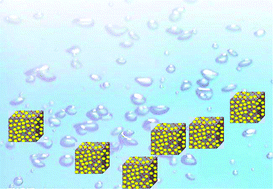当前位置:
X-MOL 学术
›
Inorg. Chem. Front.
›
论文详情
Our official English website, www.x-mol.net, welcomes your
feedback! (Note: you will need to create a separate account there.)
Ni3[Fe(CN)6]2 nanocubes boost the catalytic activity of Pt for electrochemical hydrogen evolution†
Inorganic Chemistry Frontiers ( IF 6.1 ) Pub Date : 2018-05-14 00:00:00 , DOI: 10.1039/c8qi00134k Xiao Zhang 1, 2, 3, 4, 5 , Pei Liu 1, 2, 3, 4, 5 , Yanfang Sun 5, 6, 7, 8 , Tianrong Zhan 1, 2, 3, 4, 5 , Qingyun Liu 5, 9, 10, 11 , Lin Tang 1, 2, 3, 4, 5 , Jinxue Guo 1, 2, 3, 4, 5 , Yongyao Xia 12, 13, 14, 15, 16
Inorganic Chemistry Frontiers ( IF 6.1 ) Pub Date : 2018-05-14 00:00:00 , DOI: 10.1039/c8qi00134k Xiao Zhang 1, 2, 3, 4, 5 , Pei Liu 1, 2, 3, 4, 5 , Yanfang Sun 5, 6, 7, 8 , Tianrong Zhan 1, 2, 3, 4, 5 , Qingyun Liu 5, 9, 10, 11 , Lin Tang 1, 2, 3, 4, 5 , Jinxue Guo 1, 2, 3, 4, 5 , Yongyao Xia 12, 13, 14, 15, 16
Affiliation

|
Cost-effective and highly efficient electrocatalysts for hydrogen evolution reactions (HERs) are crucial and highly desired in the sustainable energy field. Despite tremendous efforts on the development of alternative catalysts, platinum (Pt) is still the most efficient catalyst for HERs. Nevertheless, it remains a great challenge to output sufficient catalytic activity with a low Pt loading. In this research, Prussian blue analogues (PBA) of nickel hexacyanoferrate (Ni3[Fe(CN)6]2) nanocubes were used as the active substrate to enhance the HER activity of Pt by fabricating a Pt-Ni3[Fe(CN)6]2 interface. The Ni species of Ni3[Fe(CN)6]2 play key roles in contributing to the water dissociation and improving the HER kinetics, as well as helping to maintain the catalytic activity of Pt during a long-term durability test in both acidic and alkaline media. As a result, the new Ni3[Fe(CN)6]2/Pt hybrid catalyst exhibits a superior catalytic property for HERs in both sulfuric acid (H2SO4) and potassium hydroxide with a low Pt loading of only 4.0%. Impressively, a low overpotential of 59 mV is achieved at current density of 10 mA cm−2 in H2SO4, and a high mass current density of 3.75 mA μg Pt−1 is obtained at an overpotential of 70 mV, which outperforms currently reported Pt-based catalysts in acid electrolyte. It is believed that this work will inspire the design of PBA-based hybrid nanomaterials with improved or new functionalities for energy conversion and catalysis applications.
中文翻译:

Ni 3 [Fe(CN)6 ] 2纳米立方体提高了Pt催化电化学析氢的活性†
在可持续能源领域中,用于氢释放反应(HER)的具有成本效益的高效电催化剂至关重要。尽管在开发替代催化剂方面做出了巨大努力,但是铂(Pt)仍然是用于HER的最有效的催化剂。然而,在低Pt负载下输出足够的催化活性仍然是一个巨大的挑战。在这项研究中,使用六氰合铁酸镍(Ni 3 [Fe(CN)6 ] 2)纳米立方的普鲁士蓝类似物(PBA)作为活性基质,通过制造Pt-Ni 3 [Fe(CN )6 ] 2接口。Ni 3 [Fe(CN)6] 2在促进水的离解和改善HER动力学,以及在酸性和碱性介质中的长期耐久性测试过程中,帮助维持Pt的催化活性方面发挥着关键作用。结果,新的Ni 3 [Fe(CN)6 ] 2 / Pt杂化催化剂在硫酸(H 2 SO 4)和氢氧化钾中均表现出对HERs的优异催化性能,Pt负载低,仅为4.0%。令人印象深刻的是,在H 2 SO 4中的电流密度为10 mA cm -2时,实现了59 mV的低过电势,而在3.75 mAμgPt -1时,具有高的质量电流密度。在70 mV的超电势下获得了H2O,它的性能优于目前报道的酸性电解质中基于Pt的催化剂。相信这项工作将启发基于PBA的杂化纳米材料的设计,该材料具有改进的或新的功能,适用于能量转换和催化应用。
更新日期:2018-05-14
中文翻译:

Ni 3 [Fe(CN)6 ] 2纳米立方体提高了Pt催化电化学析氢的活性†
在可持续能源领域中,用于氢释放反应(HER)的具有成本效益的高效电催化剂至关重要。尽管在开发替代催化剂方面做出了巨大努力,但是铂(Pt)仍然是用于HER的最有效的催化剂。然而,在低Pt负载下输出足够的催化活性仍然是一个巨大的挑战。在这项研究中,使用六氰合铁酸镍(Ni 3 [Fe(CN)6 ] 2)纳米立方的普鲁士蓝类似物(PBA)作为活性基质,通过制造Pt-Ni 3 [Fe(CN )6 ] 2接口。Ni 3 [Fe(CN)6] 2在促进水的离解和改善HER动力学,以及在酸性和碱性介质中的长期耐久性测试过程中,帮助维持Pt的催化活性方面发挥着关键作用。结果,新的Ni 3 [Fe(CN)6 ] 2 / Pt杂化催化剂在硫酸(H 2 SO 4)和氢氧化钾中均表现出对HERs的优异催化性能,Pt负载低,仅为4.0%。令人印象深刻的是,在H 2 SO 4中的电流密度为10 mA cm -2时,实现了59 mV的低过电势,而在3.75 mAμgPt -1时,具有高的质量电流密度。在70 mV的超电势下获得了H2O,它的性能优于目前报道的酸性电解质中基于Pt的催化剂。相信这项工作将启发基于PBA的杂化纳米材料的设计,该材料具有改进的或新的功能,适用于能量转换和催化应用。











































 京公网安备 11010802027423号
京公网安备 11010802027423号